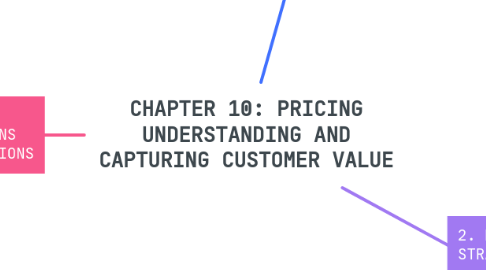
1. 3. OTHER INTERNAL AND EXTERNAL CONSIDERATIONS AFFECTING PRICE DECISIONS
1.1. Overall Marketing Strategy, Objectives, and Mix
1.1.1. Target costing=consumer value considerations + targets costs
1.1.2. Non-price strategies differentiate the marketing offer to make it worth a higher price
1.2. Organizational Considerations
1.3. The Market and Demand
1.3.1. Pricing in Different Types of Markets
1.3.1.1. Pure competition is a market with many buyers and sellers trading uniform commodities where no single buyer or seller has much effect on market price.
1.3.1.2. Monopolistic is a market with many buyers and sellers who trade over a range of prices rather than a single market price with differentiated offers
1.3.1.3. Oligopolistic competition is a market with few sellers because it is difficult for sellers to enter who are highly sensitive to each other’s pricing and marketing strategies.
1.3.1.4. Pure monopoly is a market with only one seller. In a regulated monopoly, the government permits a price that will yield a fair return. In a non-regulated monopoly,companies are free to set a market price.
1.3.2. Analyzing the Price-demand relationship
1.3.2.1. THE MARKETER MUST UNDERSTAND THE RELATIONSHIP BETWEEN PRICE AND DEMAND FOR ITS PRODUCTS
1.3.3. Price Elasticity of Demand
1.4. The Economy
1.5. Other External Factors
2. 1. WHAT IS PRICE?
2.1. Price is the amout of money charged for a product or service
2.2. Price is the only element in the marketing mix that produces revenue; all other elements represent costa
3. 2. MAJOR PRICING STRATEGIES
3.1. CUSTOMER VALUE-BASED PRICING
3.1.1. Understanding + value consumers place on + setting a price + captures that value.
3.1.2. Value-based pricing + the buyers’perception of value
3.1.3. Good-value pricing: the right combination + fair price
3.1.3.1. EVERYDAY LOW PRICING (EDLP)
3.1.3.2. HIGH-LOW PRICING
3.1.4. Value-Added Pricing = value-added features and services + support higher prices + build
3.1.4.1. Pricing power = the ability to escape price competition + justify higher prices and margins.
3.2. COST-BASED PRICING
3.2.1. Setting prices based on the costs for producing, distributing and selling the product
3.2.2. TYPES OF COSTS
3.2.2.1. FIXED COST Doesn't change, depend on production or sales level.
3.2.2.2. VARIABLE COST Changes, depends on production or sales level.
3.2.2.3. TOTAL COST Fixed cost + Variable cost
3.2.3. COSTS AT DIFFERENT LEVELS OF PRODUCTION
3.2.4. COSTS AS A FUNCTION OF PRODUCTION EXPERIENCE
3.2.5. COST-PLUS PRICING
3.2.5.1. Markup price
3.2.5.1.1. Cost-based pricing adds a standard markup to the cost of the product.
3.2.5.1.2. shows how much more a company's selling price is than the amount the item costs the company
3.2.6. BREAK-EVEN ANALYSIS AND TARGET PROFIT PRICING
3.2.6.1. Total cost = Total revenue (no profit)
3.2.6.2. Break-even Volume the amount of your product that you will need to produce and sell to cover total costs of production.
3.2.7. COMPETITION-BASED PRICING
